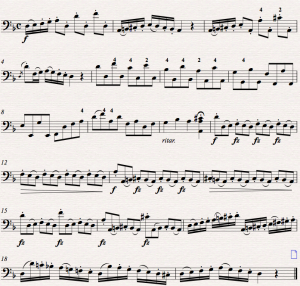Wenzl Hause was the first active bass player to write a method for the instrument, published in its final form around 1825, and he tried to incorporate as many practical elements into it as he could. The second of the three volumes of his method is a book of 90 exercises. That sounds like overkill – until you look at them more closely, at which time you’ll see that some of them aren’t more than half a page long in the original edition. Short, concise, to the point – that seems to have been Hause’s idea, rather than pages and pages of repetitive browbeating. Let’s take a look at one of these exercises, number 20, and see what issues it addresses. The fingerings are Hause’s.

This piece, in d minor, starts with staccato exercises (ms. 1-4), followed by octaves and tenths (ms. 5-10). After that, you have triplets in what I call “quick-slow” bowing and sforzati (ms. 11-16) and finally some scales, all of that also incorporating the aforementioned octaves and tenths. These are all technical issues that need to be mastered. That Hause preferred to address them in this short and concise manner doesn’t mean he didn’t think they were important; in fact, he felt quite strongly about properly learning all the technical aspects without which he felt proper musical expression would be impossible to achieve.
Getting on top of technique can very well be accomplished by doing things Hause’s way – keep to the basics, concentrate on them, and get them right, before moving on to the next issues. Hause obviously saw no need to go on for pages and pages – quantity isn’t always quality! Try it yourself, dwell a bit on each thing Hause emphasizes, and then put it all together – you’ll be surprised and pleased with the results. All of these exercises are also great for brushing up your technique and getting rid of cobwebs!
Enjoy yourselves, and have fun!
Written and added on October 29. 2014